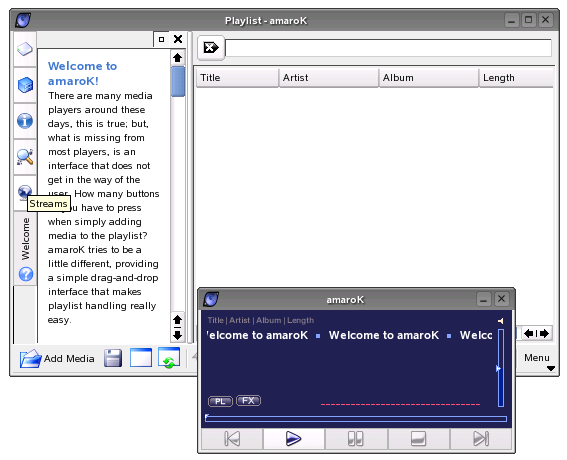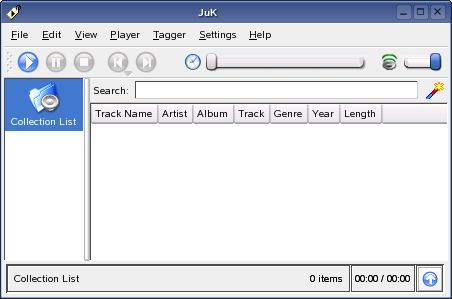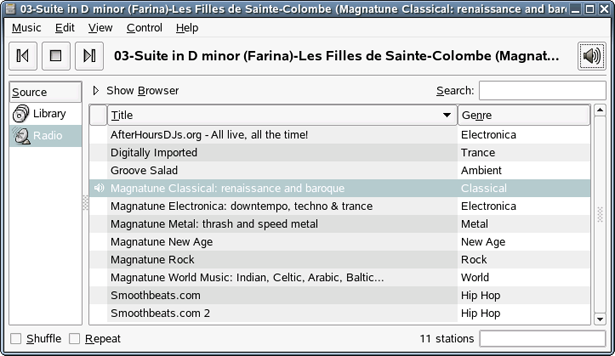7.3 Playing Music Files
NLD offers a variety of programs for playing various music formats such as MP3, OGG, and WAV files. Where possible, the supported formats of the players are listed.
7.3.1 amaroK
In addition to KsCD, which is a pure audio CD player, KDE comes with the amaroK media player, which handles various audio formats, such as MP3 and OGG, and plays the streaming audio broadcast by radio stations on the Internet. The program handles all file types supported by the sound server acting as a back end (currently aRts or GStreamer).
amaroK lets you easily create playlists with a few drag-and-drop actions. Playlists can be created using a number of different views, simplifying the management of music titles. You can also drag and drop files from Konqueror. You can save playlists in m3u or pls format so you can share them with other people using these formats.
To launch the player, click .
After starting amaroK for the first time, the program displays two windows. To open the amaroK application menu, right-click anywhere in the player window or click the drop-down list in the bottom right of the playlist window. The menu includes a Help entry, which describes the program’s numerous features.
Figure 110 The amaroK Media Player

Managing Playlists
On startup, amaroK scans the file system for multimedia files according to the settings made in the Configure General Options dialog (in the playlist window, click ). The right part of the playlist window lists any playlists found. If no playlist is found, you can create one. The best way to do this is by using the sidebar to the left of the window. To the far left, there are a number of tabs that can be used to open different views. From each of these views, drag individual titles or entire directories and drop them into the playlist. The following is a description of the tabs.
-
Context:Displays information about your collection and the current artist. For example, the view informs you about your favorite titles, the newest titles added to the collection, and other details. The Home view provides statistics on your listening habits, listing your favorite, newest, and least-played tracks. Current Track provides data related to the track currently being played, such as the album cover (see The Cover Manager), the listening statistics related to this track, and more. If you are interested in the lyrics of the track, display them using the Lyrics tab.
-
Collection Browser:Use this view to manage and display your personal collection of titles. The collection view can include files from different locations. The wrench icon in the toolbar lets you determine what locations should be scanned for music files. After you select the directories, the scan starts automatically, and the result is displayed as a tree structure. Use the Primary and Secondary menus to organize the top two branches of the tree according to Album, Artist, Genre, and Year. After the tree view is ready, find titles by typing them into the input field. The selection in the tree view automatically jumps to the first matching entry as you type. To update your collection data, rescan the file system by clicking .
-
Playlist Browser: The playlist browser is divided into two parts. The upper part lists all your custom playlists created by dragging tracks into the playlist window and clicking Save Playlist As. View the contents of the playlist by clicking the + next to the playlist’s name. Modify these playlists using drag and drop. To load one of them, double-click the playlist.
IMPORTANT: Save playlists in m3u or pls format so you can share them with other people using these formats.
amaroK can compile useful playlists (Smart Playlists) on the fly. Use the bottom part of the playlist browser to select one of the smart playlists or click to define a custom smart playlist. Enter a name, search criteria, order, and optional track limit.
-
File Browser: This tab opens a file browser that corresponds to the standard KDE file selector dialog with the usual controls for navigating the file system. Enter a URL or directory directly into the text field. From the contents displayed, you can drag elements to the playlist. You can also perform a recursive search for a file in a given directory. To do this, enter a text string for the title and the location where you want to start the search, then click and wait for the results to appear in the lower section of the window.
The Cover Manager
amaroK features a cover manager that lets you keep matching music and image data on the albums you play. To start the Cover Manager, click in the Collection Browser. A tree view in the left part of the window lists all the albums of your collection. The covers retrieved from Amazon are displayed in the right part of the window. With , you can choose what is displayed in the cover list view. lists all albums of your collection, regardless of whether they have a cover image. lists only those with a cover, and lists those lacking a cover. To retrieve cover data, choose your Amazon locale, then click . amaroK then tries to get covers for all albums contained in your collection.
Effects
Click in the player window, or right-click the player window, then click to open a dialog where you can enable and configure several sound effects, such as an equalizer, the stereo balance, and a hall effect. Select the desired effects and adjust the settings, if available, for each of them.
Visualizations
amaroK comes with a number of visualizations that display a graphical effect for the music played. Native amaroK visualizations are displayed in the player window. Cycle through the various available display modes by clicking the animation.
amaroK also supports the visualization plug-ins of the XMMS media player. To use these, first install the xmms-plugins package, then click in the playlist window. This opens a window listing the available plug-ins. XMMS plug-ins are always displayed in an extra window. In some cases, there is an option to display them in full screen mode. For some plug-ins, you might not get a smooth visual effect unless you use a 3D-accelerated graphics card.
7.3.2 JuK
JuK is a jukebox application that lets you manage your music file collection and playlists. JuK maintains a list of all files it knows about. This is called the Collection List. The collection list is specific to JuK and is not shared with other applications. Independent of the Collection List are playlists. You can have as many playlists as you want, and you can share your JuK playlists with other media players. You can also edit the tags of your music files.
To launch JuK, click .
Figure 111 JuK

7.3.3 Music Player
Music Player is an ID3 organized music library and player for your MP3, PLAC, or Ogg Vorbis music files. It lets you display information about the songs in your Library though metadata reading, create playlists by dragging and dropping from the Library view, search for entries in the Library, and listen to Internet radio stations.
To launch Music Player, click .
Figure 112 Music Player

To play a track, select the track, then click the play button on the toolbar, or simply double-click the track to start playing it. When a track ends, Music Player plays the next track in the list. In the Library, you can play all the songs from an artist, or you can play a single album.
For more information on using Music Player, click to open the Music Player Manual.